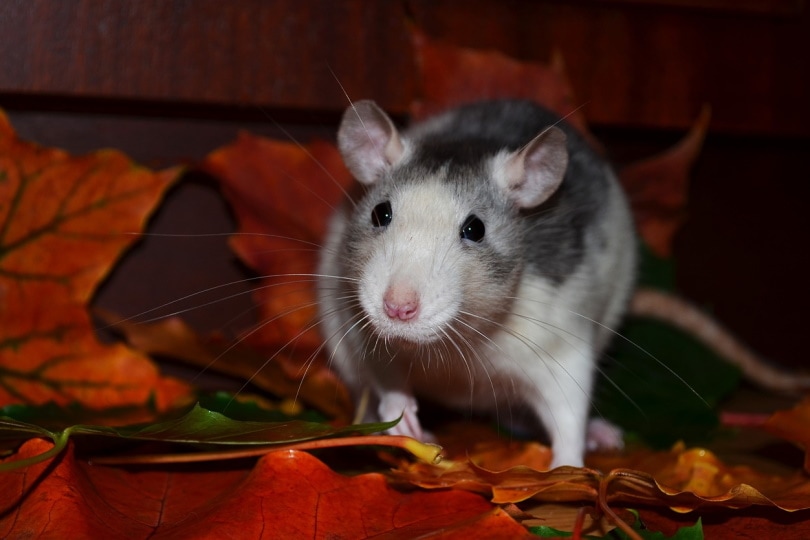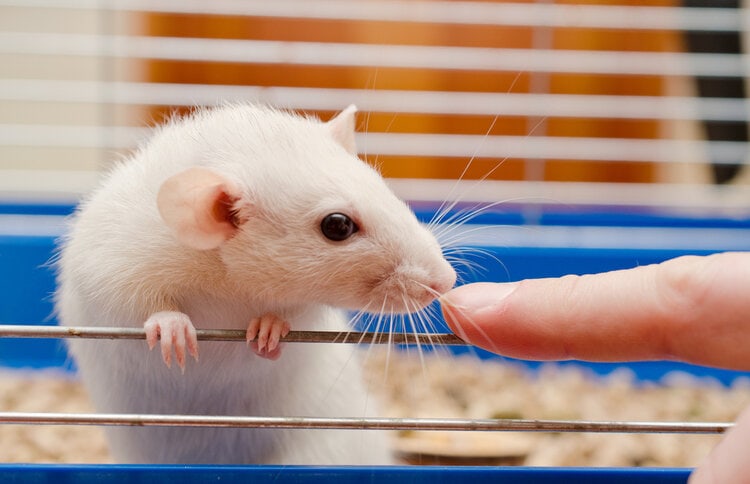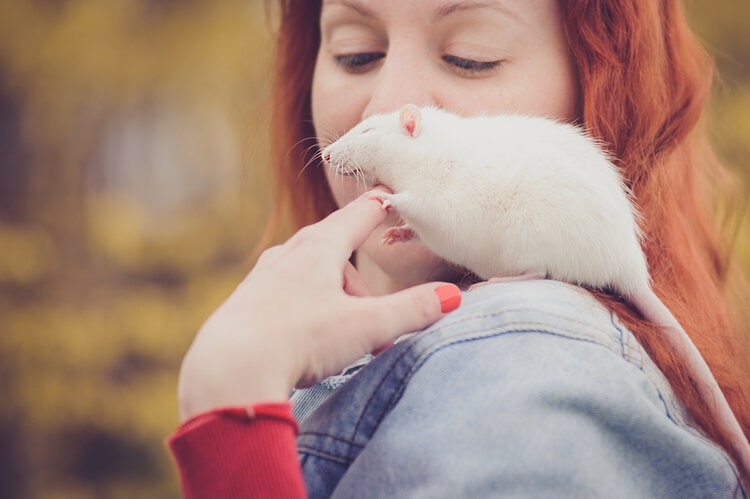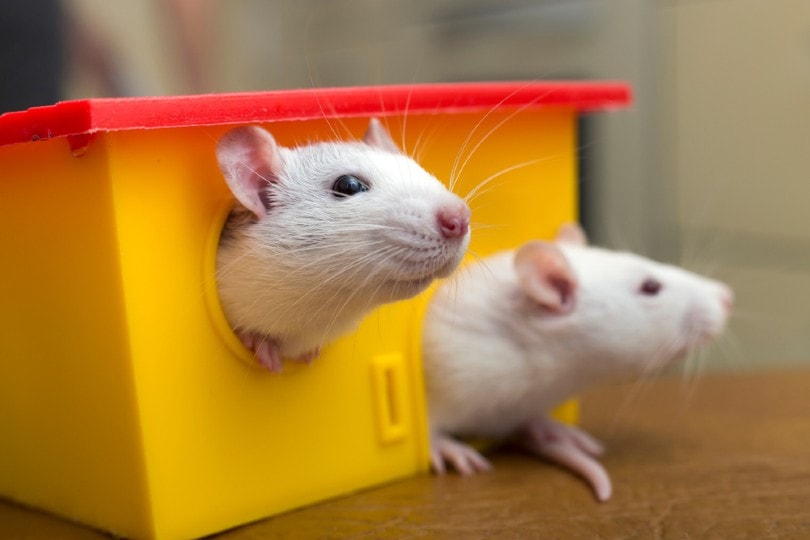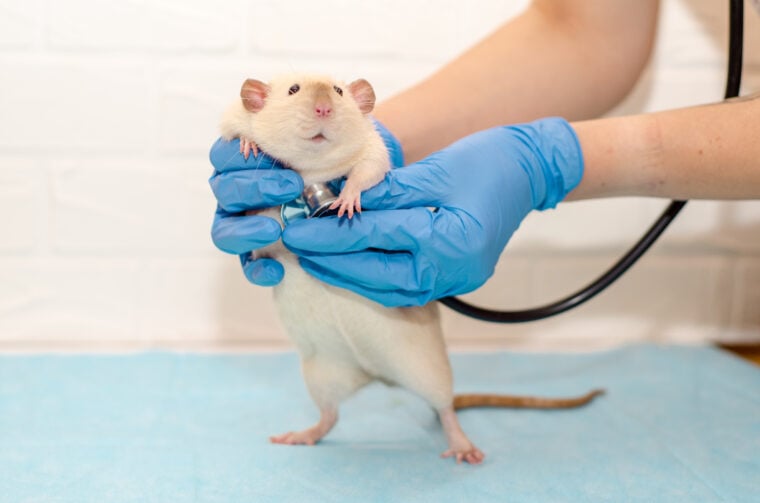
Rats make great pets! They are cute, intelligent, loving, and clean. They form special bonds with their owners and can even be trained to use the litter box and do tricks.
Although rats are usually healthy animals, they can be prone to certain medical conditions, such as mammary tumors, obesity, and respiratory diseases. Rats live for 2–3 years on average.
In this article, we go over the most common diseases in pet rats and their clinical signs.
The 6 Common Pet Rat Health Problems
Rats are healthy animals with strong immune systems, which is why they are used by researchers in various clinical studies. Pet rats, like any pet kept indoors, are less prone to illness. However, various environmental factors (hygiene and bedding) and genetics can predispose them to certain conditions. Here are the most common health problems that can affect pet rats.
1. Tumors

Rats have a high prevalence of tumors and malignancies due to genetic predisposition. While most tumors are benign, some might be malignant. To lower mortality and stop cancer from spreading (in the case of malignant tumors), tumor excision is usually recommended. Here are the most common types of cancer/tumors in pet rats:
2. Respiratory Disease
Respiratory conditions are the most common diseases of domestic rats. They are produced by various bacteria and viruses, but most often by Mycoplasma pulmonis 1, a pathogenic bacterium that is transmitted through aerosols and direct contact (from individual to individual through contaminated feces, urine, or litter) and intrauterine.
Unfortunately, the respiratory diseases caused by M. pulmonis can never be 100% treated. They are resistant to antibiotics, and the affected rats may feel well for a long time after treatment, but then the clinical signs may return. M. pulmonis persists throughout the life of the animal. However, antibiotic treatment can improve your rat’s clinical signs and quality of life for a while.
Infected rats are carriers all their lives. Stress and non-hygienic conditions can activate the bacteria, causing the previously mentioned clinical signs. To prevent or minimize the onset of the infection, here is what you can do:
3. Eye Disease

Eye problems can occur due to unsanitary conditions, stress, or if the rats fight each other. Also, pet rats can injure their eyes with foreign objects, such as wood or wires.
To prevent these problems, change the bedding often and avoid stress. Also, ensure that your rats do not fight each other and that there are no foreign objects in their cage that could cause eye injuries.
4. Dental Disease
Rats’ incisors grow continuously until they die. For this reason, rats need chewing objects to grind their teeth constantly. If you don’t provide them with items to chew on, they will start destroying the cage by chewing the plastic parts. If they don’t find anything to chew in their cage, their teeth can grow so long that they can prevent them from opening their mouths and feeding. Other clinical signs in rats with teeth problems include weight loss and a preference for soft foods.
Also, some rats can be born with malocclusion, a misalignment of the teeth (especially the incisors). This condition makes the teeth grow crooked, and the rat will not be able to grind them. As a result, rats will no longer be able to feed themselves.
To avoid or fix this problem, buy chew toys for your rats. Pet rats with malocclusion should also be taken to the vet regularly to have their teeth trimmed. If you don’t want to go to the vet often, you can ask them to surgically remove your rat’s teeth (just the ones that don’t line up).
5. Coat and Skin Disease
External parasites (lice and mites) can cause skin and fur problems for your pet rat. The bites of these parasites can cause stress to the rats so badly that they can even die.
In massive infestations, your rat’s skin may become inflamed, and you may see tiny white spots on it. Mites usually live on rats’ bodies without causing them any discomfort. When rats are stressed or sick, though, the mites can excessively multiply until they cause problems.
To avoid these problems, keep your rats in a stress-free area, clean the cage often, provide them with a balanced diet, and put the cage in a place with good ventilation.
6. Obesity

Obesity is a common problem among pet rats. This occurs as a result of an inadequate diet, which consists of too much animal protein and fruit. Rats are omnivores, so they can eat anything, but it’s important to mention that animal protein should not exceed 20% of your rat’s diet, meaning that meat or bones should be given as treats only once or twice a week. It is recommended to give a balanced diet or consult with your vet for specialized pet food. Apart from obesity, excess animal protein can also lead to dermatological problems.
Do not give sweets to your rats, and always be aware of the vegetables and fruits that could make them sick or kill them.
Summary
Pet rats are cute, healthy, intelligent, clean, and loving animals. However, like any other pet, they are prone to certain medical conditions. These include cancer (especially mammary cancer) and dental, eye, and skin diseases. Obesity is another common problem in pet rats. If you notice any change in the behavior of your pet rat, take it to the veterinarian. Diagnosing a health problem in time can prolong its life. Rats live, on average, 2 1/2 years, but there have been cases when they lived for 7 years.
Featured Image Credit: irishe4kaaa, Shutterstock



